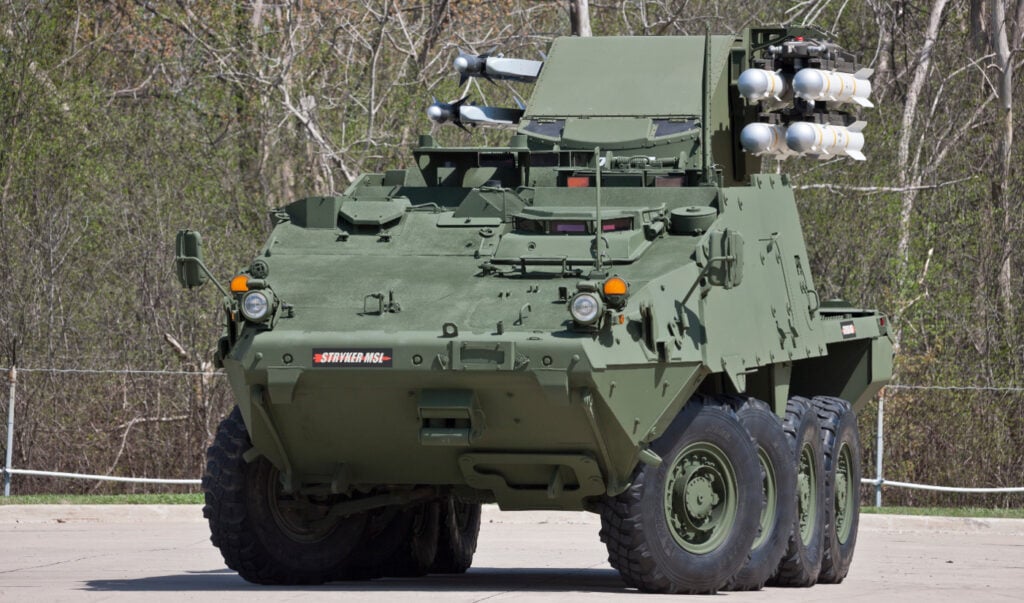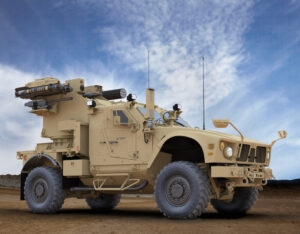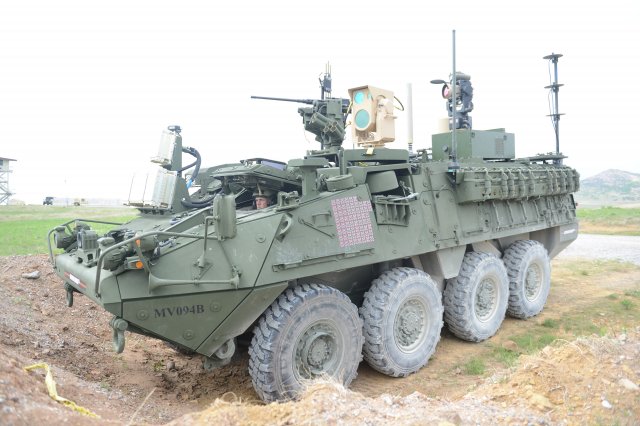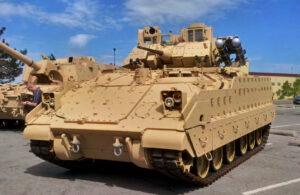Laser In Front, Grunts In Back: Boeing Offers Anti-Aircraft Vehicles
Posted on

Stryker vehicle armed with anti-aircraft missiles.
ARLINGTON: Need to shoot down Daesh drones or Russian gunships? Boeing is offering the Army an array of ways to do it, from laser-armed 8×8 Strykers to missile-launching MATV trucks and tracked Bradleys.
This September, the Army plans a “shoot off” of competing anti-aircraft systems as it tries to rebuild battlefield air defenses it largely disbanded since 9/11. Boeing’s not the only contender, but it’s been the most aggressive in showing its wares. A new anti-aircraft Stryker will debut at next week’s Space & Missile Defense Symposium in Huntsville, Ala., but that’s just one of several designs they’re prototyping. The aerospace giant has worked with makers of military vehicles – Oshkosh for the MATV, General Dynamics for Stryker, BAE for Bradley — to integrate its weapons systems on their war machines in ways that give the Army multiple options.

M-ATV with anti-aircraft missiles.
What the Army wants is Maneuver SHORAD: Short-Range Air Defense systems that can keep up with frontline combat units and survive in combat, unlike Patriot and THAAD batteries, which have longer range but are heavier and are not armored. It particularly wants Maneuver SHORAD it can afford, so installing existing weapons on existing vehicles is a lot more attractive than developing silver bullets from scratch. And, finally, the Army would love vehicles that can both carry SHORAD systems and still fulfill other roles, like troop transport.
Happily for the Army, Boeing and other companies have made laser weapons much more compact. You still need a dedicated vehicle for a 50- to 300-kilowatt weapon suitable for downing helicopters, airplanes, or (at the high end) cruise missiles, but 2- to 5-kW weapons with proven drone-killing capability can fit in existing combat vehicles. The 2 kW laser Stryker that starred in a recent Army exercise has room for several infantryman in back, but that’s a test configuration not optimized to be compact, Leary said: A properly integrated production model could fit a full nine-man squad, same as a regular Stryker.
The whole system – laser, beam director, power and cooling – is so compact you could install it on a wide range of vehicles without crowding out their other missions, Boeing executive Jim Leary told reporters this morning. Most of the time, these laser-accessorized vehicles would just go about their normal roles. But whenever an enemy tried to spy on US units with the kind of low-cost, low-altitude drones that are proliferating rapidly worldwide, there’d be someone around who could laser them out of the sky. That would stop Daesh-style drone attacks in low-tech wars and make it harder for a high-end enemy like Russia to spot targets for airstrikes and artillery.

Army laser-armed Stryker at Fort Sill.
Actually shooting down incoming artillery rockets, helicopter gunships, and strike aircraft, however, would require more powerful weapons. For now, that means missiles – although work is progressing rapidly on lasers. The Army’s current air defense vehicle is the Avenger, basically an unarmored Humvee with Stinger missiles mounted in pods, but that vehicle isn’t tough enough and that missile isn’t potent enough for a war with, say, Russia.
So Boeing, which built the original Avenger, is repurposing its turret and fire control to fire other missiles from other vehicles. As we’ve reported, the upgraded system can fire variants of both the Hellfire – made famous by Predator strikes – and the AIM-9X – used on jet fighters. What we haven’t reported in detail before is how it fits on different vehicles. There are tradeoffs.

Bradley vehicle with anti-aircraft missiles.
Boeing has worked with Oshkosh to install the upgraded Avenger turret on an MATV armored truck – the older brother of the new JLTV – and with General Dynamics to install it on a Stryker. In each case, Leary said, the missiles take up the whole back of the vehicle, replacing the passenger compartment. These would be dedicated anti-aircraft vehicles.
The M2 Bradley is a little different. There the anti-aircraft missiles would replace the TOW anti-tank missiles carried on the side of the turret (and use the same room for reloads), similar to the old M6 Linebacker. The fire control systems would be integrated into those already on the Bradley, Leary said. The anti-aircraft Bradley would retain its 25 mm chaingun, its machineguns, and its capacity to carry infantry, so it could still do all its regular missions except for killing tanks and busting bunkers.
Leary didn’t say this, but it strikes me the Army today has far more ways to kill tanks than to kill aircraft. Converting one Bradley in every four-vehicle platoon would trade a tolerable 25 percent decrease in anti-tank missiles for a new and much needed capacity for air defense – without affecting the number of infantry or scouts. Stryker units and light infantry would still need to spring for dedicated air defense vehicles, but the heavy brigades crucial to any major war would not. US armor bristling with air defense might just make the Kremlin reconsider in a crisis.
Subscribe to our newsletter
Promotions, new products and sales. Directly to your inbox.
